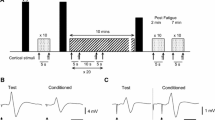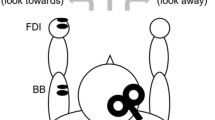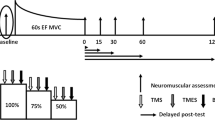Abstract
A long-duration, submaximal contraction of a hand muscle increases central fatigue during a subsequent contraction in the other hand. However, this 'cross-over' of central fatigue between limbs is small and the location within the central nervous system at which this effect occurs is unknown. We investigated this 'cross-over' by measurement of the force and EMG responses to transcranial magnetic stimulation of the motor cortex (TMS). To produce central fatigue, we used sustained maximal voluntary contractions (MVCs). In the first study, subjects (n=10) performed four 1-min sustained MVCs of the elbow flexors, alternating between the left and right arms (two MVCs per arm). The sustained MVCs were performed consecutively with no rest periods. In the second study, the same subjects made two sustained 1-min MVCs with the same arm with a 1-min rest between efforts. During each sustained MVC, a series of TMS and brachial plexus stimuli were delivered. Surface EMG was recorded from biceps brachii and brachioradialis muscles bilaterally. Voluntary activation was estimated during each MVC using measurement of the force increments to TMS. On average during each sustained MVC, voluntary activation declined by 7–12% (absolute change, P<0.001) and voluntary force declined by 35–45% MVC (P<0.001), whereas the cortical motor-evoked potential increased (P<0.001) and the subsequent silent period lengthened (P<0.001). The average voluntary activation and voluntary force were similar during two sustained MVCs performed by the same arm, when separated by 1 min of rest. However, when the 1-min rest interval was replaced with a sustained contraction performed by the other arm, the average voluntary activation was 2.9% worse in the second contraction (absolute change, P<0.05), while it did not alter voluntary force production or the EMG responses to TMS. Therefore, in maximal exercise of 4 min duration, the 'cross-over' of central fatigue between limbs is small in the elbow flexors and has a minor functional effect. Our data suggest that voluntary drive from the motor cortex is slightly less able to drive the muscle maximally after a fatiguing voluntary contraction on the contralateral side.



Similar content being viewed by others
References
Belanger AY, McComas AJ (1981) Extent of motor unit activation during effort. J Appl Physiol 51:1131–1135
Bigland-Ritchie B, Rice CL, Garland SJ, Walsh ML (1995) Task-dependent factors in fatigue of human voluntary contractions. Adv Exp Med Biol 384:361–380
Booth FW, Thomason DB (1991) Molecular and cellular adaptions of muscle in response to exercise: perspectives of various models. Physiol Rev 71:541–585
Di Lazzaro V, Restuccia D, Oliviero A, Profice P, Ferrara L, Insola A, Mazzone P, Tonali P, Rothwell JC (1998) Effects of voluntary contraction on descending volleys evoked by transcranial stimulation in conscious humans. J Physiol 508:625–633
Fitts RH (1994) Cellular mechanisms of muscle fatigue. Physiol Rev 74:49–94
Gandevia SC (2001) Spinal and supraspinal factors in human muscle fatigue. Physiol Rev 81:1725–1789
Gandevia SC, McKenzie DK, Plassman BL (1990) Activation of human respiratory muscles during different voluntary manoeuvres. J Physiol 428:387–403
Gandevia SC, Allen GM, McKenzie DK (1995) Central fatigue. Critical issues, quantification and practical implications. Adv Exp Med Biol 384:281–294
Gandevia SC, Allen GM, Butler JE, Taylor JL (1996) Supraspinal factors in human muscle fatigue: evidence for suboptimal output from the motor cortex. J Physiol 490:529–536
Gandevia SC, Petersen N, Butler JE, Taylor JL (1999) Impaired response of human motoneurones to corticospinal stimulation after voluntary exercise. J Physiol 521:749–759
Herbert RD, Gandevia SC (1996) Muscle activation in unilateral and bilateral efforts assessed by motor nerve and cortical stimulation. J Appl Physiol 80:1351–1356
Hess CW, Mills KR, Murray NMF (1987) Responses in small hand muscles from magnetic stimulation of the human brain. J Physiol 388:397–419
Hobbs SF, McCloskey DI (1987) Effects of blood pressure on force production in cat and human muscle. J Appl Physiol 63:834–839
Inghilleri M, Berardelli A, Cruccu G, Manfredi M (1993) Silent period evoked by transcranial stimulation of the human cortex and cervicomedullary junction. J Physiol 466:521–534
Loscher WN, Cresswell AG, Thorstensson A (1996) Excitatory drive to the alpha-motoneuron pool during a fatiguing submaximal contraction in man. J Physiol 491:271–280
Mathis J, de Quervain D, Hess CW (1998) Dependence of the transcranially induced silent period on the 'instruction set' and the individual reaction time. Electroencephalogr Clin Neurophysiol 109:426–435
Merton PA (1954) Voluntary strength and fatigue. J Physiol 123:553–564
Merton PA, Hill DK, Morton HB (1981) Indirect and direct stimulation of fatigued human muscle. CIBA Found Symp 82:120–126
Reid C (1928) The mechanism of voluntary muscular fatigue. J Physiol 29:17–42
Rosenbaum DA (1977) Selective adaptation of "command neurons" in the human motor system. Neuropsychologia 15:81–91
Rothwell JC, Thompson PD, Day BL, Boyd S, Marsden CD (1991) Stimulation of the human motor cortex through the scalp. Exp Physiol 76:159–200
Taylor JL, Butler JE, Allen GM, Gandevia SC (1996) Changes in motor cortical excitability during human muscle fatigue. J Physiol 490:519–528
Taylor JL, Butler JE, Gandevia SC (1999) Altered responses of human elbow flexors to peripheral-nerve and cortical stimulation during a sustained maximal voluntary contraction. Exp Brain Res 127:108–115
Taylor JL, Allen GM, Butler JE, Gandevia SC (2000) Supraspinal fatigue during intermittent maximal voluntary contractions of the human elbow flexors. J Appl Physiol 89:305–313
Ugawa Y, Terao Y, Hanajima R, Sakai K, Kanazawa I (1995) Facilitatory effect of tonic voluntary contraction on responses to motor cortex stimulation. Electroencephalogr Clin Neurophysiol 97:451–454
Williams JH, Barnes WS (1989) The positive inotropic effect of epinephrine on skeletal muscle: a brief review. Muscle Nerve 12:968–975
Wright JR, McCloskey DI, Fitzpatrick RC (2000) Effects of systemic arterial blood pressure on the contractile force of a human hand muscle. J Appl Physiol 88:1390–1396
Zijdewind I, Kernell D (2001) Bilateral interactions during contractions of intrinsic hand muscles. J Neurophysiol 85:1907–1913
Zijdewind I, Zwarts MJ, Kernell D (1998) Influence of a voluntary fatigue test on the contralateral homologous muscle in humans? Neurosci Lett 253:41–44
Acknowledgements.
This work was supported by the National Health and Medical Research Council of Australia (3206). Nicolas T. Petersen received support from Team Danmark, The Danish Sports Research Council and The Weimann Foundation. We are grateful to Dr. Jane Butler for helpful discussion of the manuscript.
Author information
Authors and Affiliations
Corresponding author
Rights and permissions
About this article
Cite this article
Todd, G., Petersen, N.T., Taylor, J.L. et al. The effect of a contralateral contraction on maximal voluntary activation and central fatigue in elbow flexor muscles. Exp Brain Res 150, 308–313 (2003). https://doi.org/10.1007/s00221-003-1379-7
Received:
Accepted:
Published:
Issue Date:
DOI: https://doi.org/10.1007/s00221-003-1379-7




